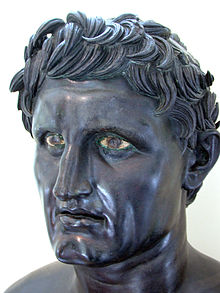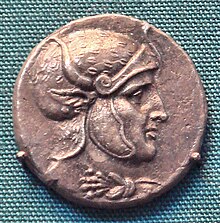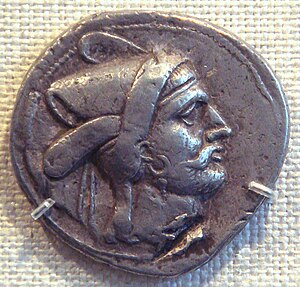|
GREEK – King Antiochos VIII (Grypos) of the Seleukid
Kingdom 121-96 B.C.
Bronze 20mm (6.18 grams) Struck 121-120 B.C.
Reference: Sear 7154; B.MC. 4. 90, 27 —
King Antiochos VIII (Grypos)
radiate head right.
Eagle standing left, scepter in background; on right, ΒΑΣΙΛΕΩΣ/ANTIOXOY; on left
, ΕΠΙΦΑΝΟΥΣ;
in field to left, IE; in exergue, Seleukid date BPP (=192=121/20
B.C.) and palm.
You are bidding on the exact item pictured,
provided with a Certificate of Authenticity and Lifetime Guarantee of
Authenticity.
The Seleucid Empire was a
Greek
–Macedonian
state that was created out of the eastern conquests of
Alexander the Great
At the height of its power,
it included central
Anatolia
, the
Levant
,
Mesopotamia
,
Persia
, today’s
Turkmenistan
,
Pamir
and parts of
Pakistan
.

Seleucus I Nicator
, the founder of
the Seleucid Empire..
The Seleucid Empire was a major center of
Hellenistic culture
which maintained the
preeminence of Greek
customs and where a
Greek
–Macedonian
political elite dominated, mostly in the urban areas.

Coin of
Seleucus I Nicator
The
Greek
population of the cities who formed the
dominant elite were reinforced by emigration from
Greece
. Seleucid expansion into Egypt was
abruptly halted after decisive defeats at the hands of the
Roman army
. Much of the eastern part of the
empire was conquered by the
Parthians
under
Mithridates I of Parthia
in the mid-2nd century
BC, yet the Seleucid kings continued to rule a
rump state
from
Syria
until the invasion by
Armenian
king
Tigranes the Great
and their ultimate overthrow
by the Roman
general
Pompey
.

Bagadates I
(Minted 290–280 BC) was the
first indigenous Seleucid satrap to be appointed
Partition
of Alexander’s empire
Alexander
conquered the
Persian Empire
under its last Achaemenid
dynast, Darius III
, within a short time-frame and died
young, leaving an expansive empire of partly Hellenised culture without an adult
heir. The empire was put under the authority of a regent in the person of
Perdiccas
in 323 BC, and the territories were
divided between Alexander’s generals, who thereby became
satraps
, at the
Partition of Babylon
in 323 BC.
Rise of Seleucus
Alexander’s generals (the
Diadochi
) jostled for supremacy over parts of
his empire.
Ptolemy
, a former general and the satrap of
Egypt
, was the first to challenge the new
system; this led to the demise of Perdiccas. Ptolemy’s revolt led to a new
subdivision of the empire with the
Partition of Triparadisus
in 320 BC.
Seleucus
, who had been “Commander-in-Chief of
the camp” under Perdiccas since 323 BC but helped to assassinate him later,
received Babylonia
, and from that point continued to
expand his dominions ruthlessly. Seleucus established himself in
Babylon
in 312 BC, the year used as the
foundation date of the Seleucid Empire. He ruled not only Babylonia, but the
entire enormous eastern part of Alexander’s empire:
“Always lying in wait for the neighboring nations, strong in arms and
persuasive in council, he [Seleucus] acquired Mesopotamia, Armenia,
‘Seleucid’ Cappadocia, Persis, Parthia, Bactria, Arabia, Tapouria,
Sogdia, Arachosia, Hyrcania, and other adjacent peoples that had been
subdued by Alexander, as far as the river Indus, so that the boundaries
of his empire were the most extensive in Asia after that of Alexander.
The whole region from Phrygia to the Indus was subject to Seleucus.”
— Appian
, The Syrian Wars
Seleucus
went as far as
India
, where after
two years of war
he reached an agreement with
Chandragupta Maurya
, in which he exchanged his
eastern territories for a considerable force of 500
war elephants
, which would play a decisive role
at
Ipsus
(301 BC).
“The Indians occupy [in part] some of the countries situated along the
Indus, which formerly belonged to the Persians: Alexander deprived the
Ariani of them, and established there settlements of his own. But
Seleucus Nicator
gave them to
Sandrocottus
in consequence of a
marriage contract, and received in return five hundred elephants.”
Westward expansion
Following his and
Lysimachus
‘ victory over
Antigonus Monophthalmus
at the decisive
Battle of Ipsus
in 301 BC, Seleucus took
control over eastern
Anatolia
and northern
Syria
.
In the latter area he founded a new capital at
Antioch on the Orontes
, a city he named after
his father. An alternative capital was established at
Seleucia on the Tigris
, north of Babylon.
Seleucus’ empire reached its greatest extent following his defeat of his
erstwhile ally, Lysimachus, at
Corupedion
in 281 BC, after which Seleucus
expanded his control to encompass western Anatolia. He hoped further to take
control of Lysimachus’ lands in Europe – primarily
Thrace
and even
Macedonia
itself, but was assassinated by
Ptolemy Ceraunus
on landing in Europe.
His son and successor,
Antiochus I Soter
, was left with an enormous
realm consisting of nearly all of the Asian portions of the Empire, but faced
with
Antigonus II Gonatas
in Macedonia and
Ptolemy II Philadelphus
in
Egypt
, he proved unable to pick up where his
father had left off in conquering the European portions of Alexander’s empire.
An overextended domain
Nevertheless, even before Seleucus’ death, it was difficult to assert control
over the vast eastern domains of the Seleucids. Seleucus invaded
India
(modern
Punjab
Pakistan
) in 305 BC,
confronting
Chandragupta Maurya
(Sandrokottos),
founder of the
Maurya empire
. It is said that Chandragupta
fielded an army of 600,000 men and 9,000 war elephants (Pliny, Natural
History VI, 22.4).
Mainstream scholarship asserts that Chandragupta received vast territory,
sealed in a treaty, west of the Indus, including the
Hindu Kush
, modern day
Afghanistan
, and the
Balochistan
province of
Pakistan
.[11][12]
Archaeologically, concrete indications of Mauryan rule, such as the inscriptions
of the
Edicts of Ashoka
, are known as far as
Kandahar
in southern Afghanistan.
|
“ |
“He (Seleucus) crossed the Indus and waged war with Sandrocottus
[Maurya], king of the Indians, who dwelt on the banks of that stream,
until they came to an understanding with each other and contracted a
marriage relationship.” |
” |
It is generally thought that Chandragupta married
Seleucus’s
daughter, or a
Macedonian
princess
, a gift from Seleucus to formalize an
alliance. In a return gesture, Chandragupta sent 500
war–elephants,[13][14][15][16][17]
a military asset which would play a decisive role at the
Battle of Ipsus
in 301 BC. In addition to this
treaty, Seleucus dispatched an ambassador,
Megasthenes
, to Chandragupta, and later
Deimakos
to his son
Bindusara
, at the Mauryan court at
Pataliputra
(modern
Patna
in
Bihar state
). Megasthenes wrote detailed
descriptions of India and Chandragupta’s reign, which have been partly preserved
to us through
Diodorus Siculus
. Later
Ptolemy II Philadelphus
, the ruler of
Ptolemaic Egypt
and contemporary of
Ashoka the Great
, is also recorded by
Pliny the Elder
as having sent an ambassador
named
Dionysius
to the Mauryan court.[18]
Other territories lost before Seleucus’ death were
Gedrosia
in the south-east of the Iranian
plateau, and, to the north of this,
Arachosia
on the west bank of the
Indus River
.
Antiochus I (reigned 281–261 BC) and his son and successor
Antiochus II Theos
(reigned 261–246 BC) were
faced with challenges in the west, including repeated wars with
Ptolemy II
and a
Celtic
invasion of Asia Minor — distracting
attention from holding the eastern portions of the Empire together. Towards the
end of Antiochus II’s reign, various provinces simultaneously asserted their
independence, such as
Bactria
under
Diodotus
,
Parthia
under
Arsaces
, and
Cappadocia
under
Ariarathes III
.
Diodotus
, governor for the
Bactrian
territory, asserted independence in
around 245 BC, although the exact date is far from certain, to form the
Greco-Bactrian
kingdom. This kingdom was
characterized by a rich
Hellenistic
culture, and was to continue its
domination of Bactria until around 125 BC, when it was overrun by the invasion
of northern nomads. One of the Greco-Bactrian kings,
Demetrius I of Bactria
, invaded India around
180 BC to form the
Greco-Indian
kingdom, lasting until around AD
20.
The Seleucid satrap of Parthia, named
Andragoras
, first claimed independence, in a
parallel to the secession of his Bactrian neighbour. Soon after however, a
Parthian tribal chief called
Arsaces
invaded the Parthian
territory around 238 BC to
form the
Arsacid Dynasty
— the starting point of the
powerful
Parthian Empire
.
By the time Antiochus II’s son
Seleucus II Callinicus
came to the throne
around 246 BC, the Seleucids seemed to be at a low ebb indeed. Seleucus II was
soon dramatically defeated in the
Third Syrian War
against
Ptolemy III of Egypt
and then had to fight a
civil war against his own brother
Antiochus Hierax
. Taking advantage of this
distraction, Bactria and Parthia seceded from the empire. In Asia Minor too, the
Seleucid dynasty seemed to be losing control — Gauls had fully established
themselves in Galatia
, semi-independent semi-Hellenized
kingdoms had sprung up in
Bithynia
,
Pontus
, and
Cappadocia
, and the city of
Pergamum
in the west was asserting its
independence under the
Attalid Dynasty
.
Revival
(223–191 BC)
A revival would begin when Seleucus II’s younger son,
Antiochus III the Great
, took the throne in 223
BC. Although initially unsuccessful in the
Fourth Syrian War
against Egypt, which led to a
defeat at the
Battle of Raphia
(217 BC), Antiochus would
prove himself to be the greatest of the Seleucid rulers after Seleucus I
himself. He spent the next ten years on his
anabasis
through the eastern parts of his
domain and restoring rebellious vassals like Parthia and
Greco-Bactria
to at least nominal obedience. He
won the
Battle of the Arius
and
besieged the Bactrian capital
, and even
emulated Alexander with an expedition into India where he met with king
Sophagasenus
receiving war elephants:
“He (Antiochus) crossed the Caucasus and descended into India; renewed
his friendship with Sophagasenus the king of the Indians; received more
elephants, until he had a hundred and fifty altogether; and having once more
provisioned his troops, set out again personally with his army: leaving
Androsthenes of Cyzicus the duty of taking home the treasure which this king
had agreed to hand over to him”. Polybius 11.39
When he returned to the west in 205 BC, Antiochus found that with the death
of
Ptolemy IV
, the situation now looked propitious
for another western campaign. Antiochus and
Philip V of Macedon
then made a pact to divide
the Ptolemaic possessions outside of Egypt, and in the
Fifth Syrian War
, the Seleucids ousted
Ptolemy V
from control of
Coele-Syria
. The
Battle of Panium
(198 BC) definitively
transferred these holdings from the Ptolemies to the Seleucids. Antiochus
appeared, at the least, to have restored the Seleucid Kingdom to glory.
Expansion into Greece and War with Rome
Following his erstwhile ally
Philip’s
defeat by Rome in 197 BC, Antiochus
saw the opportunity for expansion into Greece itself. Encouraged by the exiled
Carthaginian
general
Hannibal
, and making an alliance with the
disgruntled
Aetolian League
, Antiochus launched an invasion
across the
Hellespont
. With his huge army he was intent
upon establishing the Seleucid empire as the foremost power in the Hellenic
world but these plans put the empire on a collision course with the new
superpower of the Mediterranean, the
Roman Republic
. At the battles of
Thermopylae
and
Magnesia
, Antiochus’s forces were resoundingly
defeated and he was compelled to make peace and sign the
Treaty of Apamea
in (188 BC), the main clause
of which saw the Seleucids agree to pay a large indemnity, retreat from
Anatolia
and to never again attempt to expand
Seleucid territory west of the
Taurus Mountains
. The
Kingdom of Pergamum
and the
Republic of Rhodes
, Rome’s allies in the war,
were given the former Seleucid lands in Anatolia. Antiochus died in 187 BC on
another expedition to the east, where he sought to extract money to pay the
indemnity.
Roman power,
Parthia and Judea
The reign of his son and successor
Seleucus IV Philopator
(187-175 BC) was largely
spent in attempts to pay the large indemnity, and Seleucus was ultimately
assassinated by his minister
Heliodorus
. Seleucus’ younger brother,
Antiochus IV Epiphanes
, now seized the throne.
He attempted to restore Seleucid power and prestige with a successful war
against the old enemy,
Ptolemaic Egypt
, which met with initial success
as the Seleucids defeated and drove the Egyptian army back to
Alexandria
itself. As the king planned on how
to conclude the war, he was informed that Roman commissioners, led by the
Proconsul
Gaius Popillius Laenas
, were near and
requesting a meeting with the Seleucid king. Antiochus agreed, but when they met
and Antiochos held out his hand in friendship, Popilius placed in his hand the
tablets on which was written the decree of the senate and telling him to read
it. When the king said that he would call his friends into council and consider
what he ought to do, Popilius drew a circle in the sand around the king’s feet
with the stick he was carrying and said, “Before you step out of that circle
give me a reply to lay before the senate.” For a few moments he hesitated,
astounded at such a peremptory order, and at last replied, “I will do what the
senate thinks right.” He then chose to withdraw rather than set the empire to
war with Rome again.
The latter part of his reign saw a further disintegration of the Empire
despite his best efforts. Weakened economically, militarily and by loss of
prestige, the Empire became vulnerable to rebels in the eastern areas of the
empire, who began to further undermine the empire while the Parthians moved into
the power vacuum to take over the old Persian lands. Antiochus’ aggressive
Hellenizing (or de-Judaizing) activities provoked a full scale armed rebellion
in Judea
—the
Maccabean Revolt
.[20]
Efforts to deal with both the Parthians and the Jews as well as retain control
of the provinces at the same time proved beyond the weakened empire’s power.
Antiochus died during a military expedition against the Parthians in 164 BC.
Antiochus VIII Epiphanes/Callinicus/Philometor,
nicknamed Grypus (hook-nose), was crowned as ruler of the
Greek
Seleucid kingdom
in 125 BC. He was the son of
Demetrius II Nicator
and
Cleopatra Thea
.
Biography
Antiochus Grypus was crowned as a teenager in 125 BC after
his mother
Cleopatra Thea
had killed his elder brother
Seleucus V Philometor
, ruling jointly with her. After Antiochus defeated
usurper
Alexander II Zabinas
in 123 BC his mother tried to poison him with wine, but
the suspicious king forced her to drink the cup herself. (The story may have
been inspired by the fact that Grypus was interested in toxicology; some poems
about poisonous herbs believed to have been written by him are quoted by the
famous physician Galen
).
Either he or his half brother
Antiochus IX Cyzicenus
is probably identical with the ephemeral child ruler
Antiochus Epiphanes, who was crowned by
Cleopatra Thea
after the death of Antiochus VII but before Demetrius II
returned to Antioch. The child Antiochus Epiphanes, who is known from coins, was
deposed—but not killed—when Demetrius II was restored in 129 B.C.
Despite political shortcomings, Grypus was a popular king.
His ugly, lazy appearance on coins (common among the last Seleucids), together
with stories of his lavish banquets, made posterity believe his dynasty was
degenerated and decadent. This was however a conscious image, an invocation of
the Hellenistic idea Tryphe – meaning good life, which the last Seleucids
strove to be associated with, as opposed to the exhausting civil wars and feuds
which troubled their reigns in reality.
A story of his luxurious parties claims he sent food home
with guests whom attended banquets, complete with a camel as beast of burden, as
well as a with attendant to carry the guest himself. This should certainly have
caused some strain on the already depleted treasury.[
neededcitation]
Family
He married the
Ptolemaic
princess Tryphaena (see
Cleopatra VI of Egypt
), but in 116 BC his half-brother and cousin
Antiochus IX Cyzicenus
(see
Antiochus VII Sidetes
) returned from exile and a
civil war
began. Cyzicenus’ wife, also named Cleopatra, was a half-sister of Tryphaena and
was eventually killed in a dramatic fashion in the temple of
Daphne
outside
Antioch
, on
the order of Tryphaena. Cyzicenus eventually killed Tryphaena as revenge. The
two brothers then divided
Syria
between
them until Grypus was killed by his minister Heracleon in 96 BC.
Five of Grypus’ sons later rose to kingship:
This contributed to the confusion of civil war amid which the
Seleucid empire ended.
He also had at least one daughter:
-
Laodice VII Thea
, married to king
Mithridates I Callinicus
of
Commagene
as part of a settlement by Mithridates’ father
Sames II Theosebes Dikaios
to ensure peace between the Kingdom of
Commagene and the
Seleucid Empire
. Laodice and Mithridates’ son was king
Antiochus I Theos of Commagene
. This was a grandson to Grypus.
|











